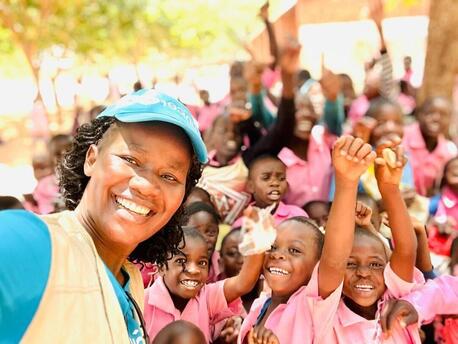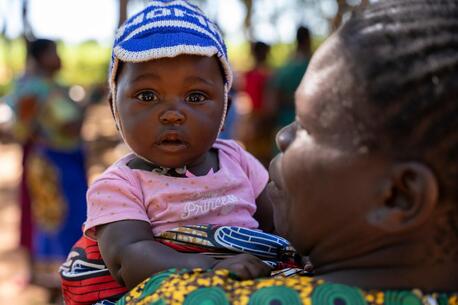Ten Environmental Problems the World Must Face Now
The science is clear. Our health and prosperity and that of the environment go hand in hand. Here are ten issues we must tackle to set things straight.
UNICEF and partners are working tirelessly all over the world to save and protect children.
In the fifth century B.C., Hippocrates explained the connection between the health of the planet and all living beings this way:
“If you want to learn about the health of a population,” the "Father of Medicine" observed, “look at the air they breathe, the water they drink, and the places where they live."
Over 2,000 years later, we now know a lot about the diseases an unhealthy environment causes — everything from developmental disorders to cancer. It’s also become clear that children pay the highest price.
According to the State of Global Air (SOGA) 2019, breathing toxic air will shorten the lifespan of children born today by 20 months — 30 months for those in Asia.
According to a March 2019 report from the UN Environment Program (UNEP), human activity, exacerbated by climate change, is damaging the planet so severely that our health is increasingly at risk.
“The science is clear. The health and prosperity of humanity are directly tied to the state of our environment,” said Joyce Msuya, Acting Executive Director of UNEP. “We are at a crossroads. Do we continue on our current path, which will lead to a bleak future for humankind, or pivot to sustainable development? That is the choice our political leaders must make, now.”
In the study Gathering Storm: Climate Change Clouds the Future of Children in Bangladesh, UNICEF recently sounded the alarm for the 19 million children in Bangladesh who are increasingly endangered by devastating floods, cyclones and other environmental disasters linked to climate change.
More susceptible to toxins than adults, children's exposure to environmental threats can trigger lifelong consequences. And air pollution and climate change are by no means the only problems. Mold and lead, common contaminants in substandard housing, subject children to a higher risk of kidney and central nervous system damage. Unsafe water, a major hazard for children in developing countries, causes diseases and infections that are especially hard for a child who's malnourished to fight off.
Although the world's international organizations, financial institutions and governments must band together to address climate change and other environmental threats, individuals can do their part, too, by adopting eco-friendly habits and committing to sustainable living. Raising awareness of the problems an unhealthy environment poses to children is another way to take meaningful action before it’s too late.
Last year was a tough one for the environment
Severe weather and natural disasters made 2018 especially difficult — and costly. Weather disasters were estimated to cost over $155 billion. Coastal regions of the U.S. were pummeled by numerous storms: Hurricane Michael, Hurricane Florence, Tropical Storm Lane and Subtropical Storm Alberto. The New England Bomb Cyclone brought unprecedented rainstorms and flooding to the East Coast, and California experienced three separate bouts of wildfires, one of which triggered severe mudslides.
In fact, severe weather spanned the globe in 2018. Windstorm Friederike wreaked havoc in Germany, France, Belgium, the Netherlands and Poland. In Asia, the extreme weather pattern continued with tsunamis in Indonesia, flooding and mudslides in Japan, Cyclone Josie in Fiji and Super Typhoon Mangkhut, which affected the Marshall Islands, the Philippines, China and Guam. In addition to these deadly storms, the Mt. Fuego volcano erupted in Guatemala, dust storms plagued India and Papua New Guinea, Mexico and Taiwan all experienced major earthquakes. In 2019, cyclones and flooding have already devastated parts of Mozambique and Malawi.
Here's what we need to focus on to save ourselves and our planet
1. Climate Change: Changing climate patterns and rising global temperatures are perhaps the most pressing of all the problems facing the planet. Melting glaciers, higher sea levels, coastal erosion, extreme weather, heat waves, infectious disease and disrupted agricultural patterns are all triggered by climate change, which disproportionately threatens children. Those living at lower elevations may see their homelands entirely submerged by water by the time they become adults. Children are also most vulnerable to many of the contagious diseases climate change exacerbates.
2. Air Pollution: A mix of gases and solid particles in the air, air pollution is a severe problem in both urban and rural areas of the world. Vehicles, factories and fires are among the most significant contributors to air pollution, which is a serious problem for developing countries with weaker regulatory controls. Even those nations with more stringent regulations grapple with harmful levels of air pollution. Exposure to polluted air is especially dangerous for children, whose lungs and immune systems are still developing.
3. Water Shortages: Many regions around the world have suffered severe water shortages in recent years, with India experiencing its worst shortage ever. 2017's El Nino-triggered drought has forced Cape Town, South Africa to predict that its taps will run dry in 2019. Climate change, overpopulation and mismanagement all contribute to water scarcity. The consequences for the health and survival of humans — as well as that of crops and livestock — are devastating, especially for children who are more susceptible to dehydration and malnutrition. The impact on hygiene can also be lethal. When people don't have clean water for washing and food preparation, diseases flourish and spread, posing particular threats to children.
4. Ocean Threats: Oceans cover over 70 percent of the Earth’s surface, so any threat to the ocean, like pollution or overfishing, is a threat to the entire planet. Oil spills, industrial runoff, pesticides and sewage are just a few of the contaminants endangering the world's oceans. But common consumer waste like plastic bags and straws also ends up in the ocean, threatening sea life. For children who live in coastal areas, an unhealthy ocean is a hazard. Swimming in contaminated water can make them sick. And if there’s no suitable alternative food source, communities that live primarily on fish are vulnerable to malnutrition, the effects of which are more detrimental to children. Families who earn their livelihoods fishing will have less to spend on their children’s health and education, which can harm their long-term prospects.
5. Shrinking Wetlands: Though it doesn’t receive much attention, shrinking wetlands is a serious issue. Industrial and agricultural development, invasive species, pollution, damming and rising water levels are all contributing to the destruction of our wetlands. As wetlands disappear, the vast numbers of species that call them home are jeopardized, as are the livelihoods and food supplies of people who rely upon them for rice cultivation. Wetlands also blunt the impact of dangerous storms. Without that protection, the public health crises that often follow deadly storms — like the cholera epidemic in Mozambique that UNICEF is now battling in the wake of Cyclone Idai — are likely to grow worse.
6. Desertification: Desert climates can't do much to sustain life; that’s why deserts from California to Mongolia have always been some of the most sparsely inhabited parts of the world. But today, drought, deforestation and unsustainable agriculture practices have turned a growing number of places that were once fertile into arid desert-like terrain. When lakes and rivers dry up, and the land can't support wildlife and vegetation, food and water shortages cause dehydration and malnutrition, which is especially dangerous for children. Children — especially girls — are also often the ones making long journeys to fetch water, which can leave little time for the education that's so vital to their futures.
7. Habitat Destruction: Habitats around the world are being destroyed by commercial development and irreparably altered by climate change. As a result, more and more species are heading toward extinction, an event that is reducing biodiversity and disrupting ecosystems and food chains. When one species becomes extinct, other animal populations may grow too quickly, displacing others, degrading land and disturbing vegetation. Habitat destruction has far-reaching consequences for land fertility, water resources and food production and supply, which are all essential to human survival.
8. World Hunger: Hunger, which has been on the rise since 2016, is one of the world's most devastating humanitarian problems, with one in nine people in the world going hungry today. Hunger has multiple causes, many of them stemming from climate change, including the disrupted rainfall patterns and agricultural seasons, which have triggered droughts and floods. Hunger leads to malnutrition, which is especially devastating for children — and deadly in its most severe form. Children who live with chronic malnutrition are vulnerable to stunting, delayed development and disease, all of which can have lifelong consequences.
9. Ozone Depletion: The ozone layer, found in the Earth’s stratosphere, is the shield that helps protect the planet from the sun’s UV rays. But the release of chemicals into the atmosphere has eroded the ozone, compromising its ability to keep those harmful rays from reaching the Earth's surface. Children are especially susceptible to UV rays, and without proper protection can face a lifelong risk of developing skin cancer.
10. Extreme Weather: Hurricanes, tsunamis, drought, wildfires, heavy precipitation, tornadoes, extreme heat and cold are some of the most visible consequences of climate change. Children are most vulnerable in nearly allof these scenarios. They’re more susceptible to heatstroke, hypothermia and smoke inhalation and more likely to drown during flooding. Among the most dangerous diseases for children are cholera and diarrhea, which often accompany hurricanes, floods and tsunamis.
UNICEF works to curb the impact of extreme weather and other environmental shocks in many ways, including:
- designing water systems that can withstand cyclones and salt water contamination
- strengthening school structures and supporting preparedness drills
- supporting community health systems in risk-prone areas
- prepositioning supplies ahead of major weather events
UNICEF is there before, during and after emergencies. Please donate now.
HOW TO HELP
There are many ways to make a difference
War, famine, poverty, natural disasters — threats to the world's children keep coming. But UNICEF won't stop working to keep children healthy and safe.
UNICEF works in over 190 countries and territories — more places than any other children's organization. UNICEF has the world's largest humanitarian warehouse and, when disaster strikes, can get supplies almost anywhere within 72 hours. Constantly innovating, always advocating for a better world for children, UNICEF works to ensure that every child can grow up healthy, educated, protected and respected.
Would you like to help give all children the opportunity to reach their full potential? There are many ways to get involved.





